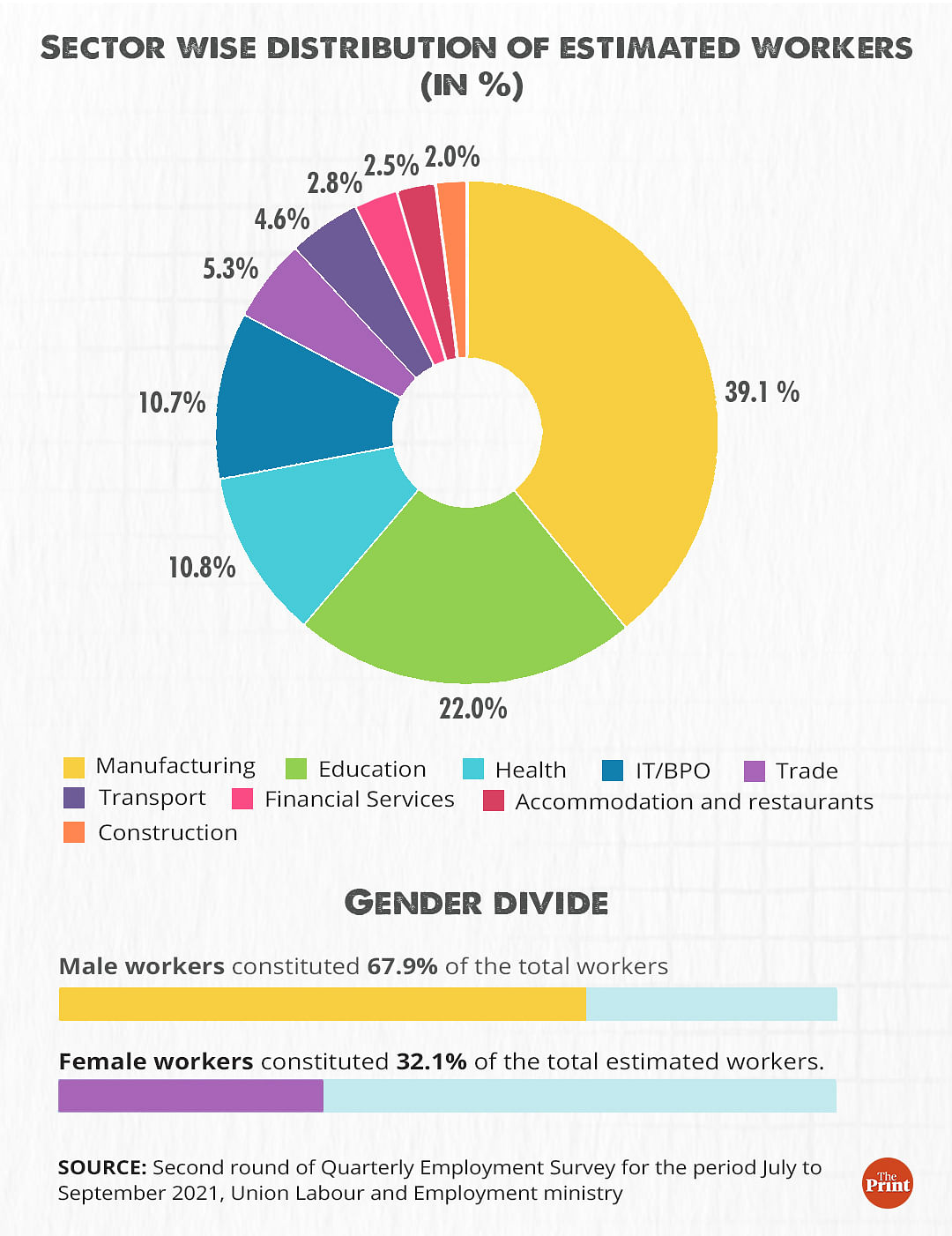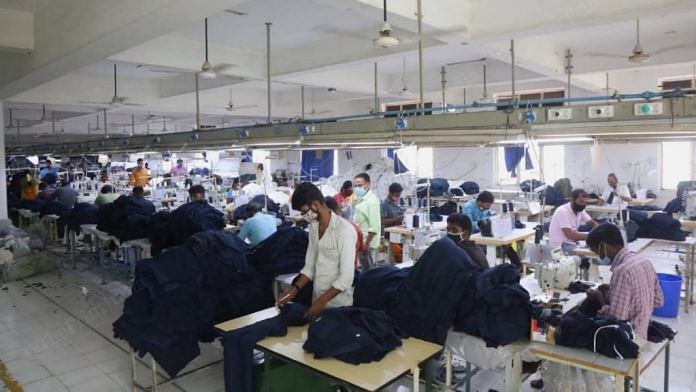New Delhi: The estimated number of jobs in nine key sectors, including manufacturing, education, health and the IT/BPO sector, increased by two lakh to reach a total of 3.10 crore between July and September 2021 as the second wave of the Covid-19 pandemic subsided, compared to the previous quarter, according to the second round of the Union labour ministry’s quarterly employment survey (QES) released Monday.
Overall percentage of female workers in these sectors has also increased, the survey shows.
The estimated total employment increased from 3.08 crore jobs in the April-June quarter to 3.10 crore jobs in July-September 2021, with the manufacturing sector clocking the maximum growth and now covering 39.1 per cent of total employment, followed by education (22 per cent) and health (10.8 per cent).
The QES has compared the employment data with the 6th Economic Census conducted in 2013-14, when the total employment for these nine sectors taken collectively was reported at 2.37 crore. The result of the 7th Economic Census, which was conducted in 2020 is yet to be made public.
The nine sectors that are part of the survey are manufacturing, education, transport, trade, construction, Information Technology (IT)/Business Process Outsourcing (BPO), accomodation and restaurant, health, and financial services.
Also read: India’s unemployment rate hits 4-month high of 7.9% in December amid Covid surge
Increase in percentage of female workers
“The QES shows that there has been an increase of two lakh jobs in the July-September quarter compared to the April-June quarter, which is a healthy sign,” Union labour minister Bhupender Yadav said after releasing the report.
Yadav said that another important trend that came out in the QES was that the overall percentage of female workers also increased — from 29.3 per cent in the April-June quarter to 32.1 per cent in the July-September quarter.

Earlier, the government used the Periodic Labour Force Survey (PLFS), conducted by the Ministry of Statistics and Programme Implementation, for getting employment sector data. But Yadav said that PLFS gave just supply side information of the labour market.
It was to address this gap that the labour ministry last year initiated the All India Quarterly Establishment-based Employment Survey (AQEES). It aims to provide estimates of employment, vacancies, training and other related parameters for major nine non-farm sectors of the economy.
The QES is a component of AQEES, covering establishments with at least 10 workers. The other component, AFES (Area Frame Establishment Survey), will capture information about establishments with less than 10 workers.
“The QES gives a consolidated view of employment from demand side at regular intervals. This data will help the government make evidence-based policy,” Yadav added.
Manufacturing, education employ most
The QES report showed that manufacturing accounted for 39 per cent of the total estimated jobs, followed by education with 22 per cent and health as well as IT/BPOs sectors both around 10 per cent. Trade and transport sectors engaged 5.3 per cent and 4.6 per cent of the total estimated workers respectively.
The survey also revealed that regular workers constitute 87 per cent of the estimated workforce in the nine selected sectors, with only 2 per cent being casual workers. However, in the construction sector, 20 per cent of the workers were contractual and 6.4 per cent were casual workers.
Also, 98.3 per cent of the establishments were located outside households, though 5.1 per cent of units in the accommodation and restaurants sector — the highest among all sectors — were found to operate from within households.
90% units had less than 100 workers
The QES shows that nearly 90 per cent of the establishments surveyed have been estimated to work with less than 100 workers, though 30 per cent of the IT/BPO establishments worked with at least 100 workers, including about 12 per cent engaging 500 workers or more. In the first round of the QES, 91 per cent of establishments were reported to have worked with less than 100 workers in the IT/BPO sector.
In the health sector, 19 per cent of the establishments had 100 or more workers. Also, in the case of the transport sector, 14 per cent of the total estimated establishments were operating with 100 or more workers.
Educational qualification
The survey shows that 28.4 per cent of those working in seven of the nine sectors (excluding education and health) were matriculates/secondary or less educated, while another 37 per cent were graduates or had higher qualifications.
At 91.6 per cent, the maximum number of graduates or those with higher education were found to be working in the IT/BPO sector, followed by 59.8 per cent in financial services. In the health sector, as few as 18 per cent of the non-clinical workers were matriculates/secondary or less educated.
Vacancies
For all the sectors combined, the survey shows that 5.6 per cent of the total establishments reported vacancies. In absolute terms, the number of vacancies in all the establishments taken together was 4.3 lakh. In 65.8 per cent of cases, the reason for vacancies was non-specific.
About 23 per cent vacancies happened due to resignation and the remaining 11.7 per cent vacancies occurred due to retirement of employees. Overall, four sectors — education, manufacturing, IT/BPOs, and health — accounted for 91 per cent of the reported vacancies, the survey shows.
(Edited by Saikat Niyogi)
Also read: Omicron unlikely to be a concern, staffing firm report predicts better job prospects in Q4






